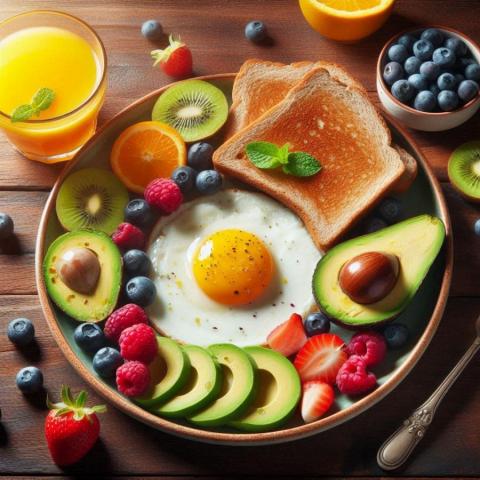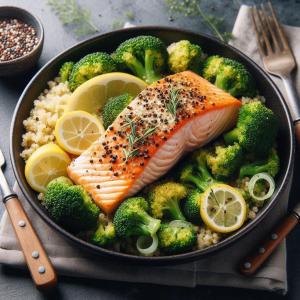
Vegetarianism and veganism are popular lifestyle choices centered around the exclusion of animal products from one's diet. While both focus on plant-based eating, there are critical differences:
-
Vegetarians abstain from meat but may consume dairy, eggs, and other animal-derived products.
-
Vegans avoid all animal products, including meat, dairy, eggs, and often other by-products like honey and gelatin.
This guide provides a structured introduction to these diets, outlining benefits, nutritional considerations, food choices, and tips for beginners.
Benefits of Vegetarian and Vegan Diets
-
Health Benefits
-
Heart Health: Lower cholesterol levels and reduced risk of heart disease due to high intake of fruits, vegetables, and whole grains.
-
Weight Management: Plant-based diets are often lower in calories and high in fiber, aiding in weight control.
-
Diabetes Control: Improved blood sugar levels and reduced risk of Type 2 diabetes.
-
Cancer Prevention: Lower risks of certain cancers, including colon and breast cancer.
-
-
Environmental Benefits
-
Reduced Carbon Footprint: Lower greenhouse gas emissions compared to meat production.
-
Conservation of Resources: Less water and land use, reduced deforestation.
-
-
Ethical Considerations
-
Animal Welfare: Reducing or eliminating animal products helps decrease demand for factory farming and animal suffering.
-
Nutritional Considerations
To ensure a balanced diet, focus on the following nutrients that might be less abundant in vegetarian and vegan diets:
-
Protein
-
Sources: Legumes (beans, lentils, chickpeas), tofu, tempeh, seitan, quinoa, nuts, seeds.
-
Tip: Combine different protein sources to get all essential amino acids.
-
-
Vitamin B12
-
Sources for Vegetarians: Dairy products, eggs.
-
Sources for Vegans: Fortified foods (plant milks, breakfast cereals) or supplements.
-
Tip: Regularly monitor B12 levels and consider a daily supplement if needed.
-
-
Iron
-
Sources: Lentils, chickpeas, beans, tofu, fortified cereals, spinach.
-
Tip: Consume with vitamin C-rich foods to enhance absorption (e.g., bell peppers, citrus fruits).
-
-
Calcium
-
Sources: Fortified plant milks and juices, tofu, tahini, almonds, leafy greens (bok choy, kale).
-
Tip: Include a variety of calcium-rich foods daily.
-
-
Omega-3 Fatty Acids
-
Sources: Flaxseeds, chia seeds, hemp seeds, walnuts, algae-based supplements.
-
Tip: Consider a DHA supplement derived from algae for direct omega-3s.
-
-
Vitamin D
-
Sources: Fortified plant milks, fortified orange juice, mushrooms, sunlight.
-
Tip: Supplement during winter months or if living in low-sunlight areas.
-
-
Zinc
-
Sources: Legumes, nuts, seeds, whole grains, fortified cereals.
-
Tip: Soak or sprout beans and grains to enhance zinc absorption.
-
-
Iodine
-
Sources: Iodized salt, sea vegetables (kelp, nori), supplements.
-
Tip: Use iodized salt for cooking.
-
Food Choices and Meal Planning
-
Staples of a Vegetarian/Vegan Pantry
-
Grains: Brown rice, quinoa, oats, whole wheat pasta.
-
Legumes: Lentils, black beans, chickpeas, split peas.
-
Vegetables: Leafy greens, cruciferous vegetables, root vegetables, squashes.
-
Fruits: Berries, apples, bananas, citrus, melons.
-
Nuts and Seeds: Almonds, walnuts, chia seeds, flaxseeds, pumpkin seeds.
-
Protein Sources: Tofu, tempeh, seitan, edamame, plant-based meat alternatives.
-
Oils and Fats: Olive oil, coconut oil, nut butters, avocado.
-
-
Sample Meal Plan
-
Breakfast: Overnight oats with almond milk, chia seeds, fresh berries, and a drizzle of maple syrup.
-
Lunch: Quinoa salad with chickpeas, cherry tomatoes, cucumbers, and a tahini dressing.
-
Snack: Hummus with carrot sticks and whole-grain crackers.
-
Dinner: Stir-fried tofu with broccoli, bell peppers, and brown rice.
-
Dessert: Dark chocolate and a handful of almonds.
-
-
Tips for Eating Out
-
Research Restaurants: Look for vegetarian or vegan-friendly options.
-
Ask for Modifications: Request to leave out dairy or meat from dishes.
-
Choose Ethnic Cuisines: Indian, Thai, Mediterranean, and Middle Eastern cuisines often have plant-based dishes.
-
Transition Tips for Beginners
-
Start Slowly
-
Meatless Days: Begin with a few meatless days each week.
-
Substitute Gradually: Replace animal products with plant-based alternatives progressively.
-
-
Educate Yourself
-
Recipes and Cooking: Experiment with vegetarian and vegan recipes.
-
Nutritional Knowledge: Learn about essential nutrients and how to get them.
-
-
Find Support
-
Community: Join online forums, local groups, or social media communities.
-
Books and Blogs: Read about others' experiences and get inspired by vegan cookbooks and blogs.
-
-
Stay Balanced
-
Variety: Ensure a diverse intake of foods to cover nutritional needs.
-
Avoid Processed Foods: Focus on whole foods rather than processed meat substitutes.
-
Common Myths and Misconceptions
-
Vegetarians/Vegans Don’t Get Enough Protein
-
Fact: Adequate protein can be obtained from a variety of plant sources.
-
-
Vegetarian/Vegan Diets Are Automatically Healthy
-
Fact: Like any diet, they can be unhealthy if high in processed foods or low in essential nutrients.
-
-
It’s Hard to Eat Out or Travel
-
Fact: With growing awareness, many places offer vegetarian/vegan options. Planning ahead can ease the process.
-
-
Veganism Is Expensive
-
Fact: Staple foods like beans, grains, and vegetables are often cheaper than meat and dairy.
-
Conclusion
Adopting a vegetarian or vegan diet can be a rewarding lifestyle choice that benefits your health, the environment, and animal welfare. By focusing on a balanced, nutrient-rich diet and embracing a variety of plant-based foods, you can successfully transition to and thrive on a vegetarian or vegan diet. Start slowly, educate yourself, and enjoy the journey towards a more compassionate and sustainable way of eating.






